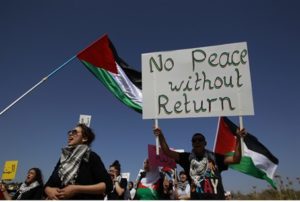70 years of shooting refugees

‘No peace without return’ demonstration
Jake Batinga writes in The Electronic Intifada:
Since March 2018, weekly protests – known as the Great March of Return – have been held in Gaza.The demonstrators are insisting that people uprooted by Zionist forces during the Nakba – the 1948 ethnic cleansing of Palestine – be allowed to go home. This right of return has been recognized by United Nations General Assembly resolution 194, passed in December 1948. Israel has responded brutally to demands that this basic right be upheld. More than 210 Palestinians have been killed during the Great March of Return and more than 9,000 have been injured by live fire.
As well as insisting that the right to return be respected, Palestinian refugees have occasionally attempted to exercise that right over the past seven decades. In doing so, they have been treated with extreme violence.
In the years following the adoption of UN resolution 194, large numbers of people living in Gaza tried to cross the boundary with Israel, a newly established state. In an Orwellian turn of phrase, the Israeli authorities designated these returning refugees as “infiltrators. In his book Israel’s Border Wars, the historian Benny Morris writes that the so-called infiltration was “a direct consequence of the dispossession of hundreds of thousands of Palestinians.” Refugees sought to reunite with family, tend crops, recover lost possessions and, of course, see their old homes.
Israel’s Border Wars was published in 1997 – seven years before Morris argued that Zionist forces should have expelled all Palestinians in the 1940s. Despite his attempts to defend ethnic cleansing, Morris has never repudiated the important facts he had previously unearthed. And we can continue to learn a considerable amount from his work about crimes committed in the name of Israel and its state ideology Zionism.
He recounts, for example, how Israel operated a “free fire” policy on refugees seeking to return home. According to Morris, Israeli forces “fired at anything that moved” and often executed injured refugees “on the spot.” Between 2,700 and 5,000 refugees were killed under the free fire policy, the vast majority of whom were unarmed civilians, from 1949 to 1956. Furthermore, “no Israeli soldier, policeman, or civilian was ever tried for shooting and killing an unarmed Arab infiltrator,” Morris writes.
